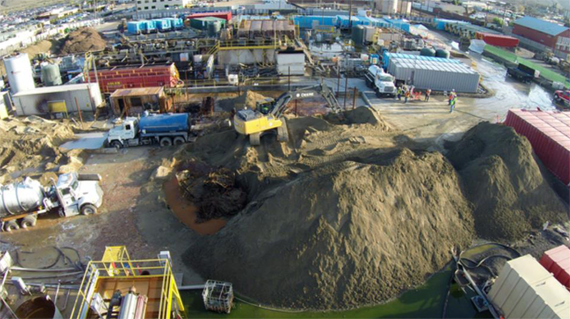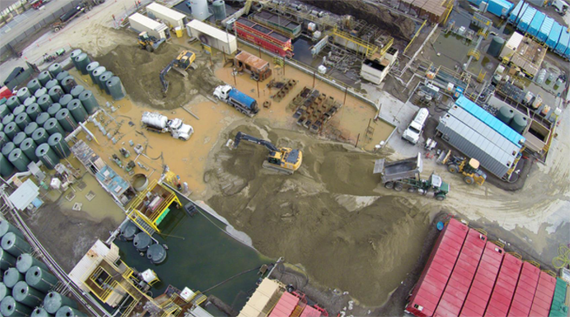A government report notes that the facility stores numerous hazardous chemicals and that the company has not adhered to required business practices.
In addition, the county’s chief medical officer said there are plans to follow up on the health of all those exposed to fumes released during the incidents.
The incident started at 3:45 a.m. with the first explosion of what officials believe was a SCWW vacuum truck that spewed more than 1,000 gallons of unknown chemicals hundreds of feet in all directions. The initial explosion left two men injured, one critically.
Just hours later a vapor cloud exploded igniting chemicals stored at the company - believed to include sulfuric acid - that created a three-mile long plume of toxic smoke.
In all, 55 people were injured including three Santa Paula Firefighters that were first on the scene. The firefighters are now on medical leave while being treated for respiratory illnesses that resulted from inhaling the unknown substances.
Although arriving emergency responders were repeatedly assured by those at SCWW that the spillage was sewer wastewater as the substances dried they crystallized and spontaneously combusted. Santa Paula Fire and Ventura County Fire engines were abandoned at the site and an evacuation called for.
Although officials are saying it will probably never be known what actually exploded - not unusual as chemicals can be destroyed by fire, diluted by subsequent rain events and erode with the passage of time - Ventura County Supervisor Linda Parks said at a December 16, 2014 meeting she is also concerned about what remains on site.
Although the company notes it only accepts non-hazardous waste - the waste streams processed at the facility, more than 100 varieties, were sent through a 12-mile pipeline to the Oxnard wastewater plant - there is a “toxic cocktail” at the facility, located at 815 Mission Rock Road.
According to a government report, an inventory summarized chemicals reported to be on the site prior to the initial explosion and fire.
“It is believed that other unknown chemicals were also present,” notes the report.
“Maximum amounts” listed as being onsite at the time of the November 18, 2014 explosions and fires were inventoried with their common name and included - among other materials - those that are highly explosive and those that are highly dangerous if exposure occurs. The list includes oxygen (1,000 cubic feet); acetylene (600 cubic feet); potassium permanganate (1,500 pounds); 320-L polymer (1,980 gallons); 460-TC polymer (660 gallons); chlorine tablets (2,750 tablets); hydrogen peroxide (3,300 gallons); sodium hypochlorite (990 gallons); aluminum chloride (1,650 gallons); anionic polymer (2,750 gallons); emulsion breaker (110 gallons); ferric sulfate (3,300 gallons); and sulfuric acid 93-99% (600 gallons).
The Ventura County Board of Supervisors last got an update at the December 16, 2014 meeting after the extension of the local emergency created by the explosion was pulled from the consent calendar, the portion of the agenda usually reserved for items not warranting discussion.
Chris Stephens, Director of the County’s Resource Management Agency, told supervisors that officials - which includes county, state and federal agencies - continue work at the site and “We’ve made a great deal of progress...
“We’ve also begun testing those containers... there are quite a few on site and we’re testing each and every one,” said Stephens of SCWW’s inventory.
Testing, once stymied due to the volatility of the unknown chemicals and the refusal of labs to handle it, has begun and there has been no evidence of radiological material that caused Oxnard to pull the SCWW permit and shut off the city’s wastewater intact valve.
“The site has been neutralized and cleaned up with the exception of the ‘lake’ in the center of the facility where the initial explosion occurred. That area is expected to be neutralized, solidified and removed in the next three weeks.”
Hundreds of on-site tests were conducted to identify the materials involved and determine their safety.
As the volatility of the materials involved subsided, Stephens said more than 50 samples were sent to off-site laboratories for more extensive testing. All of the tests returned negative results, indicating the tested areas were non-hazardous.
The solidified material will be subjected to “Another round of testing” that Stephens said would determine if the material is hazardous; if found to be dangerous it would require dumping at a special out-of-state facility.
Supervisors were told that numerous off-site soil and the Food and Drug Administration, Environmental Protection Agency and the California Department of Public Health conducted produce tests in the agricultural areas surrounding the waste disposal plant with the assistance of the Ventura County Agricultural Commissioner’s Office.
The tests looked for volatile organic and semi-volatile organic compounds as well as a 21-page list of pesticides and metals.
Every test, said Agricultural Commissioner Henry Gonzales, came back “non-detect” or “essentially non-detect... it is my professional opinion that the produce from the area is safe to harvest and consume.”
But growers as well as farmworkers were affected by the blasts and shutdown of farming operations that led to lost crops and lack of work while the area was tested and cleared.
Stephens said SCWW will not be allowed to reopen until three conditions are met: the site must be completely cleaned and deemed safe, the company must demonstrate is ability to operate the facility safely, and there must be an agreement from the city of Oxnard to accept products from the facility.
A government report notes that although on December 3, 2014 the operator of SCWW “has asked if he could resume limited operations at the site,” such a request was found “inconsistent” with the clean up operation and investigation.
In addition, “the facility currently does not have a Storm Water Plan, a SPCC [Spill Prevention, Control, and Countermeasure] plan, or a functional business plan with a contingency for release.”
At the December 16, 2014 supervisors meeting Dr. Robert Levin, Health Officer/Medical Director for Ventura County Public Health, said after “speaking with Kevin McGowan [VCSD Office of Emergency Services] about this situation one of the things we plan on doing is following up on the health of those affected by this,” approximately 50 patients in addition to those initially injured in the blast as well as Santa Paula’s firefighters.
Levin said follow-up will include monitoring, “what kind of effects,” and health impacts - whether temporary or long-term - are experienced by those that were exposed to the unknown chemicals.
During the presentation there was no mention of the criminal investigation launched by the District Attorney’s Office shortly after the explosions and fires.




